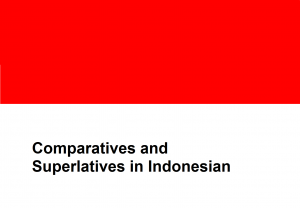Language/Indonesian/Grammar/Comaratives-and-Superlatives
Hello everybody! 🌟
In today's lesson, you will learn some valuable vocabulary about ¨COMPARATIVES AND SUPERLATIVES¨ in Indonesian. This essential aspect of Indonesian grammar will help you express differences and comparisons more effectively. 😊
Feel free to edit this page by adding new words and expressions! Your contributions will help others learn and grow in their understanding of the Indonesian language.
Good learning! 📚
As you continue your journey in mastering Indonesian grammar, don't forget to explore other related topics such as Indonesian Word Order, Indonesian Gender, and Past Participle in Indonesian. These lessons will provide you with a comprehensive understanding of the language and its intricacies.
Happy learning, and enjoy your Indonesian language adventure!
Comparative[edit | edit source]
When you want to express your opinion about something, use these forms:
Noun A + lebih + adjective + daripada + Noun B
The same as in English form "-er ending for adjective" or "more".
Noun A + kurang + adjective + dari + Noun B
The same as in English form "less".
Those are the patterns that we use for the positive statement.
When we want to express the negative one, just put a word "tidak" before "lebih" on the patterns.
Notice that we don't usually put that word before the "kurang" form because it sounds weird.
For example:
- Kucing itu tidak lebih besar daripada seekor rubah
That cat is not bigger than a fox.
Example[edit | edit source]
- Albert lebih pintar daripada Benny
Albert is smarter than Benny.
- Willy kurang tinggi dari Cassie
Willy is less tall than Cassie.
- Rumah itu tidak lebih indah daripada rumah Amy
That house is not more beautiful than Amy's house.
For information[edit | edit source]
Unlike in English that has two common ways to express the comparative, there are "-er/more" form and "less" form.
In Indonesia, we usually use the first pattern which we told above, it is lebih .... daripada than second one although it also makes sense.
Superlatives[edit | edit source]
In Indonesian, superlatives are used to compare one thing to others and to show the highest degree or level of a quality. There are two ways to form superlatives in Indonesian: using the word "paling" or using the suffix "-nya".
Using "Paling"[edit | edit source]
To form a superlative using "paling", we simply add the word "paling" in front of the adjective or adverb that we want to compare. For example:
- Dia paling tinggi di antara teman-temannya. (He is the tallest among his friends.)
- Rumah ini paling besar di lingkungan ini. (This house is the biggest in this neighborhood.)
- Buku ini paling menarik dari semua buku yang pernah saya baca. (This book is the most interesting of all the books I have read.)
Using "-nya"[edit | edit source]
To form a superlative using "-nya", we add the suffix "-nya" to the adjective or adverb that we want to compare. For example:
- Dia tingginya di antara teman-temannya. (He is the tallest among his friends.)
- Rumah ini besarnya melebihi rumah-rumah lain di lingkungan ini. (This house is bigger than other houses in this neighborhood.)
- Buku ini menariknya melebihi semua buku yang pernah saya baca. (This book is more interesting than all the books I have read.)
Note: The use of "paling" is more common and considered more formal than using "-nya".
To make superlatives of nouns, we use the word "yang" before the noun and then add the superlative form of the adjective or adverb. For example:
- Ibu saya yang paling rajin. (My mother is the most diligent.)
- Teman saya yang paling cerdas. (My friend is the most intelligent.)
In Indonesian, it's important to remember that the superlative form of the adjective or adverb doesn't change according to gender or number. It remains the same for singular and plural forms of the noun.
Other Lessons[edit | edit source]
- Prepositions
- Why Learn Indonesian
- Conditional Mood
- Negation
- Present Tense
- How to Use Have
- Future Tense
- Indefinite Articles in Indonesian
- Gender
- Past Tense

